Physical Address
304 North Cardinal St.
Dorchester Center, MA 02124
Originally viewed as smooth muscle tumors (leiomyoblastomas), it is now known that gastrointestinal stromal tumors ( GISTs ) arise from interstitial cells of Cajal (ICCs) or ICC precursor cells. ICCs are pacemaker cells centered on the myenteric plexus along the entire length of the tubal gut ( Fig. 17.1 ). They function to set up a peristaltic wave that coordinates the movement of food through the digestive system. GISTs have many morphologic, immunohistochemical, and molecular features in common with ICCs. The identification of KIT gene mutations in most GISTs has made them a paradigm for targeted therapy of oncogenic proteins and oncogene addiction in solid tumors. Many developments in GIST diagnostics in the last 20 years have accompanied genetic findings of therapeutic importance.
Although once considered rare, GISTs are now known to be the most common human sarcoma because of increased diagnostic reliability. Population-based studies estimate the annual incidence at 10 cases per million. It should be emphasized that these are clinically significant GISTs greater than 2 cm in size that require surgical evaluation and potentially systemic therapy. MicroGISTs , less than 1 cm in diameter, are quite common. Autopsy studies have identified microGISTs, known variably as GIST tumorlets or GISTlets, in up to 22.5% of patients. However, the vast majority of microGISTs do not progress to clinically important lesions that require medical attention.
GISTs arise over a wide age range, from children to elderly persons, with a peak median age of 64 years at diagnosis. They occur with an approximately equal sex predilection (47.3% female; 52.7% male), except in children, with a clear female predominance (see pediatric GIST later). No etiologic factors related to GIST have been identified. However, although the vast majority of GISTs occur as sporadic tumors with somatic mutations, GISTs also occur rarely in various tumor syndromes (see later). They are found along the entire length of the digestive tract but are most common in the stomach (60%), jejunum and ileum (30%), duodenum (5%), and colon and rectum (<5%). GISTs also rarely involve the esophagus, appendix, and gallbladder.
A small number of GISTs have no apparent connection to the gastrointestinal (GI) tract. These GISTs, known as extragastrointestinal GISTs ( EGISTs ), involve the omentum, mesentery, retroperitoneum, and perineum. The occasional finding of an omental or mesenteric GIST with a thin stalk attached to the stomach suggests that a subset of EGISTs are exophytic GISTs that arose within the GI tract but eventually lost their connection to it. This is supported by molecular findings showing that EGISTs in the omentum share molecular characteristics with gastric GISTs.
Presenting symptoms include GI bleeding, anemia, abdominal fullness, or a mass. GISTs can also present asymptomatically; because they arise from the wall of the gut, they do not become symptomatic until they erode/ulcerate the overlying mucosa or become large enough to cause masslike symptoms.
GISTs have a characteristic pattern of metastasis. Unlike epithelial neoplasms of the gut, with one specific exception, succinate dehydrogenase (SDH)–deficient GISTs (see later), they do not metastasize to lymph nodes. They metastasize to the liver or disseminate throughout the peritoneal cavity as numerous metastatic nodules. It is unusual for GIST to metastasize outside the abdomen, but dermal/subcutaneous, bone, brain, and lung metastases occur rarely.
GISTs range in size from 1 mm to very large tumors, occasionally measuring greater than 20 cm, with a median size of clinically significant GISTs of 6 cm in the stomach, 4.5 cm in the duodenum, and 7 cm in the jejunum/ileum. Because GISTs arise from ICCs or ICC precursors, they are centered on the wall of the gut ( Figs. 17.2 and 17.3 ). This has important clinical ramifications because endoscopic biopsies may not be deep enough to obtain suitable tissue for a diagnosis. The use of endoscopic ultrasound and fine-needle aspiration overcomes this limitation by directing the biopsy needle directly into the lesion. GISTs frequently ulcerate the overlying mucosa. On cross section, they are tan and fleshy with frequent cystification and hemorrhage. Necrosis can occur but is less common. GISTs usually grow as single tumor nodules, but occasionally they are multifocal. Multifocality suggests a germline mutation or inherited disorder that predisposes to GIST or the presence of metastasis.
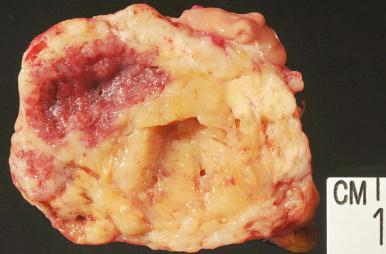
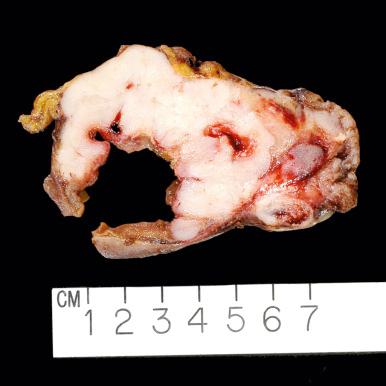
GISTs are centered on the muscularis propria and are usually circumscribed and tend to respect the muscularis mucosae ( Fig. 17.4 ). When GISTs invade across the muscularis mucosae to involve the overlying mucosa, the lesional cells infiltrate among the glands. It is important to distinguish true invasion from simple erosion of the overlying mucosa, because true invasion is associated with a worse prognosis and is almost always associated with aggressive clinical behavior. Lymphovascular invasion is very uncommon except in SDH-deficient GISTs, approximately 50% of which metastasize to lymph nodes.
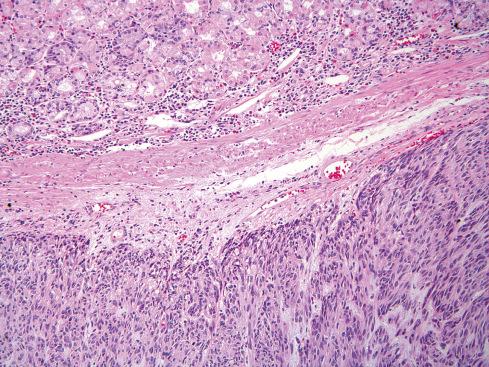
GISTs can have predominantly epithelioid (20%) or spindle cell (70%) cytomorphology, or a combination of both (10%), and range from hypocellular to densely cellular lesions. The spindle cells have elongated nuclei with fine chromatin, inconspicuous nucleoli, and a moderate amount of pale eosinophilic and fibrillary cytoplasm. Whereas epithelioid GISTs can be arranged in a sheetlike or nested growth pattern ( Figs. 17.5 and 17.6 ), spindle cell GISTs are always arranged in fascicles ( Figs. 17.7 to 17.9 ). The stroma varies from hyalinized to occasionally myxoid. Coarse calcifications and stromal hyalinization are typical of small, clinically insignificant microGISTs ( Fig. 17.10 ). GISTs of all types are usually monomorphic with minimal cytologic pleomorphism. They also tend to have minimal mitotic activity. Atypical mitotic figures are rare and are usually a harbinger of high-grade or dedifferentiated GIST.
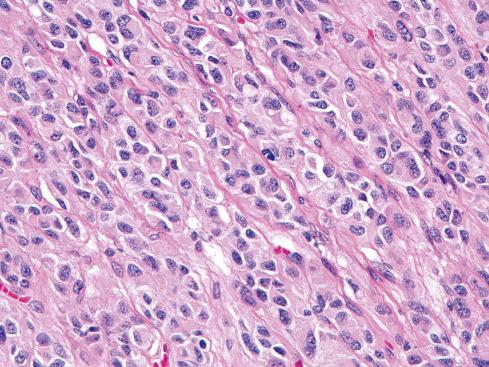
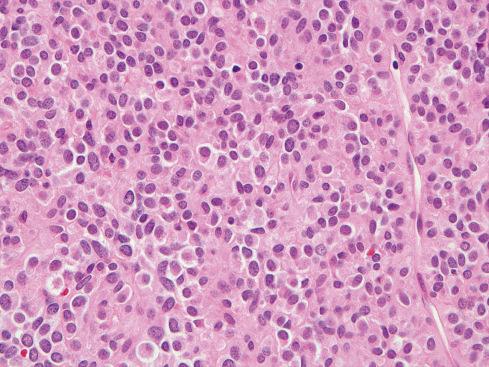
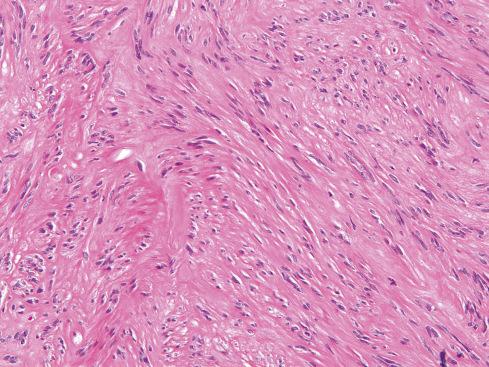
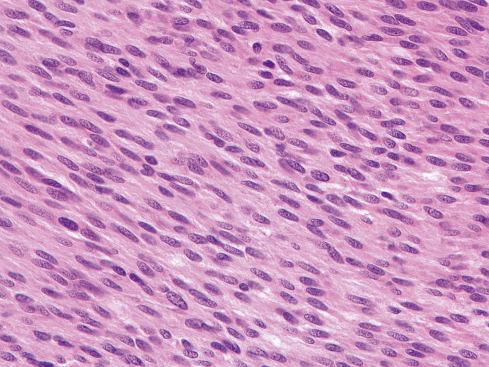
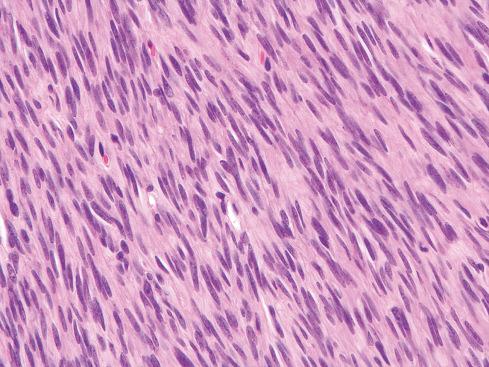
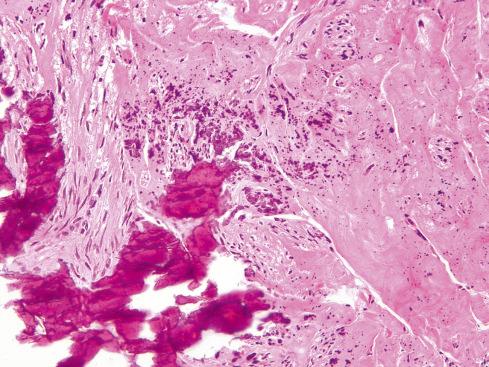
GISTs are well vascularized, and in occasional examples the blood vessels can be hyalinized, mimicking schwannoma ( Fig. 17.11 ). Gastric GISTs can have striking nuclear palisading, also mimicking schwannoma ( Fig. 17.12 ). Ironically, gastric schwannomas are uniformly cellular and do not usually exhibit obvious nuclear palisading. Gastric GISTs can also have prominent cytoplasmic vacuolization ( Fig. 17.13 ). Another interesting histologic feature frequently encountered in GIST is the presence of so-called skeinoid fibers, prominent deposits of collagen that are periodic acid–Schiff (PAS) positive ( Fig. 17.14 ), which occur almost exclusively in small intestine GISTs.
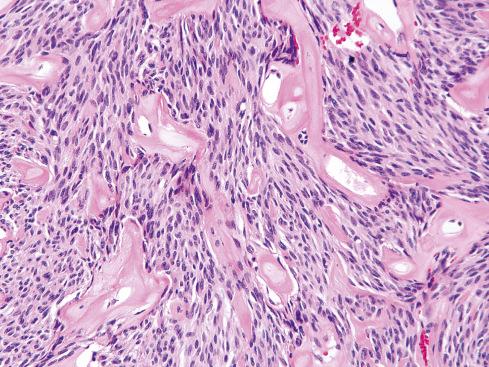
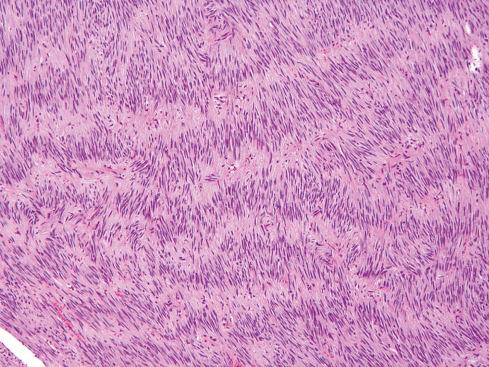
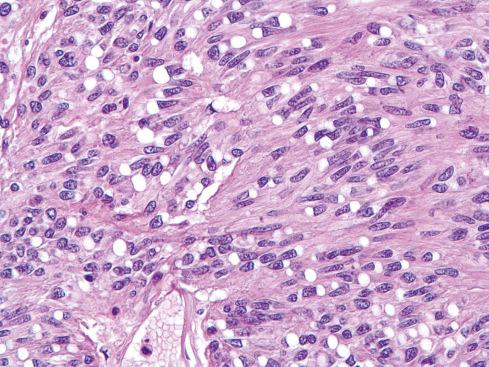
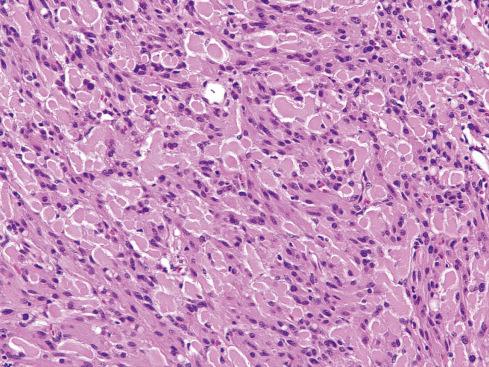
Dedifferentiated GISTs are characterized by the presence of morphologically typical GIST juxtaposed with high-grade sarcoma. These lesions are very rare, but the high-grade sarcomatous component loses KIT and/or DOG1 immunoreactivity, is more mitotically active including atypical mitotic figures, and is clinically more aggressive than usual GIST ( Figs. 17.15 and 17.16 ). Dedifferentiated GIST can be seen de novo or as a result of prolonged anti-KIT tyrosine kinase inhibitor therapy.


GISTs are diffusely and strongly positive for KIT (CD117, c-kit) in approximately 95% of cases. Immunoreactivity can be cytoplasmic ( Fig. 17.17 ), membranous ( Fig. 17.18 ), dotlike perinuclear ( Fig. 17.19 ), or a combination of all these patterns. There is no clinical significance to the different staining patterns. Because other GI neoplasms, such as leiomyoma and schwannoma, can mimic GIST, it is important to confirm the histologic impression of GIST by confirmation with KIT immunohistochemistry (IHC).
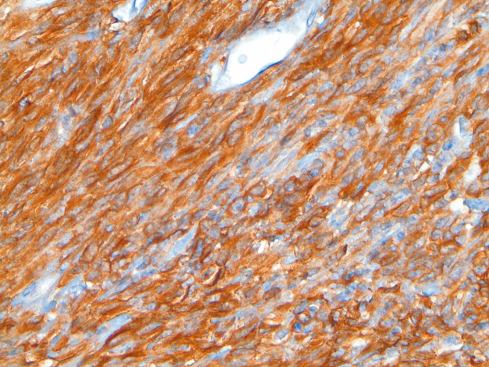
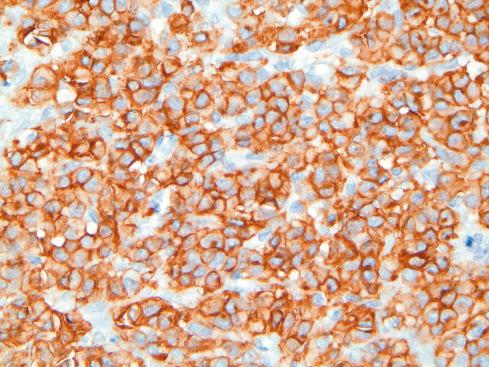
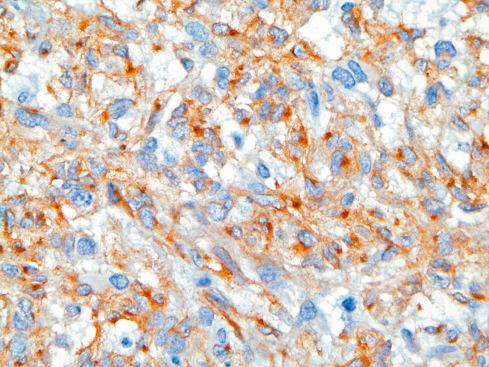
Approximately 5% of GISTs are negative for KIT on IHC. Virtually all these GISTs are found to be PDGFRA mutant GISTs ( Table 17.1 ; see later section).
| Immunohistochemistry | Genotype | |||||
|---|---|---|---|---|---|---|
| KIT Mutation | PDGFRA Mutation | BRAF Mutation | NF1 Mutation | SDHB, SDHC, or SDHD Mutation | SDHA Mutation | |
| KIT | + | − (weak) | + | + | + | + |
| DOG1 | + | + | + | + | + | + |
| SDHB | Retained | Retained | Retained | Retained | Lost | Lost |
| SDHA | Retained | Retained | Retained | Retained | Retained | Lost |
| BRAF V600E | − | − | + | − | − | − |
DOG1 (discovered on GIST 1), also known as ANO1 (anoctamin-1), is strongly expressed in ICC and is very sensitive and specific for the diagnosis of GIST. DOG1 is strongly expressed in more than 99% of GISTs ( Fig. 17.20 ). Importantly, it is positive in most KIT-negative GISTs and therefore is useful in confirming the diagnosis of GIST in this subgroup ( Fig. 17.21 ). To ensure that a diagnosis of GIST is not missed, it is recommended that both KIT and DOG1 IHC be used in all cases of suspected GIST.

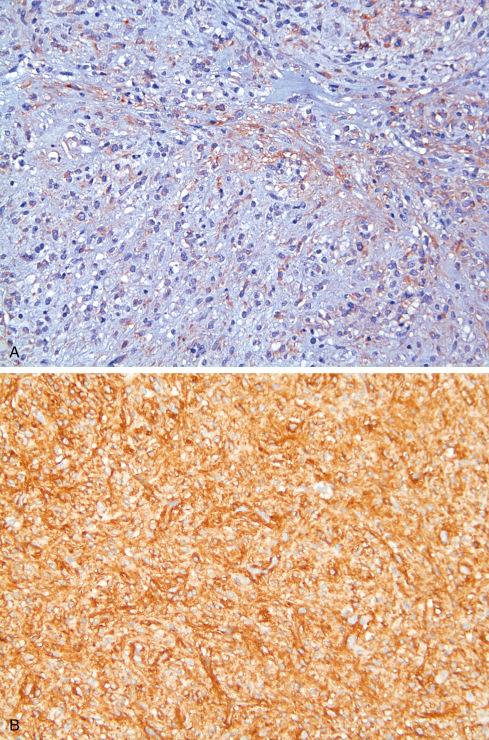
GISTs are also positive for CD34 (70%), but this immunohistochemical marker is no longer useful for the diagnosis of GIST. Before the advent of KIT IHC, CD34 was the “go-to” marker for diagnosing GIST. GISTs are also positive for smooth muscle actin (SMA) in 30% to 40% of cases. In general, staining is more focal than seen in leiomyomas and leiomyosarcomas . However, it is important to keep SMA immunoreactivity in mind for the possible pitfall of misdiagnosing a GIST as a smooth muscle tumor. GISTs are occasionally positive for S-100 (5%), desmin (2%), and cytokeratins (2%), which is helpful in distinguishing GIST from schwannoma (KIT negative, diffusely S-100 positive), smooth muscle tumor (KIT negative, desmin positive), and metaplastic (sarcomatoid) carcinoma (KIT negative, keratin positive). S-100, desmin, and cytokeratins, when positive, are usually only focally positive in GIST. Also, melanoma , which occasionally metastasizes to the bowel, is both S-100 and KIT positive, although the degree of KIT immunoreactivity is typically less than seen in GIST. For the differential diagnosis of GIST, the most useful basic immunohistochemical panel is KIT, DOG1, S-100, and desmin ( Table 17.2 ).
| Diagnosis | KIT | DOG1 | Desmin | S-100 |
|---|---|---|---|---|
| GIST | +++ (95%) | +++ (99%) | − (2%) Focal | − (5%) Focal |
| Leiomyoma | − | − | +++ (100%) Uniform | − |
| Leiomyosarcoma | − | − | ++ (50%) | − |
| Schwannoma | − | − | − | +++ (100%) Uniform |
| Desmoid Fibromatosis | − | − | − | − |
Become a Clinical Tree membership for Full access and enjoy Unlimited articles
If you are a member. Log in here